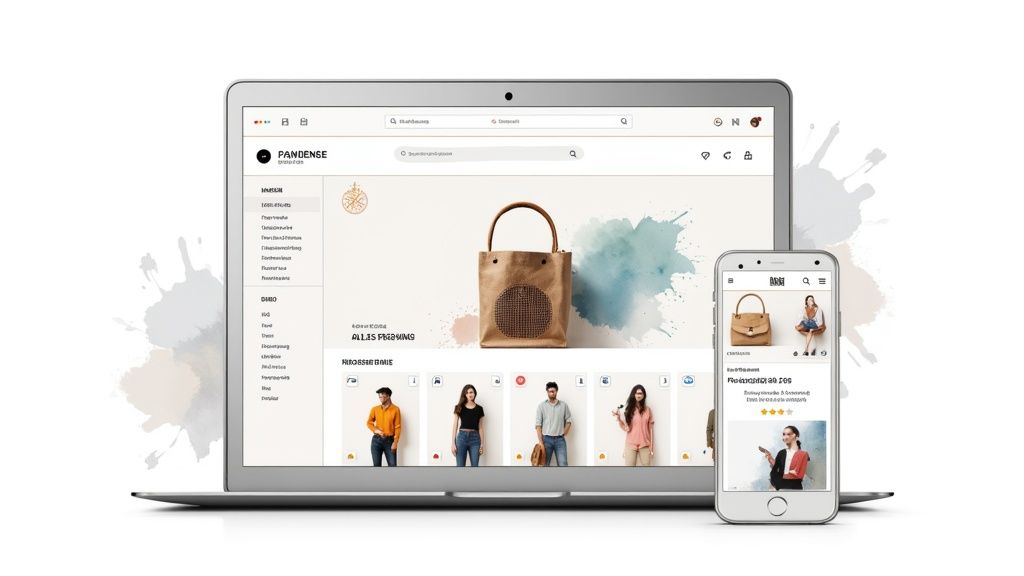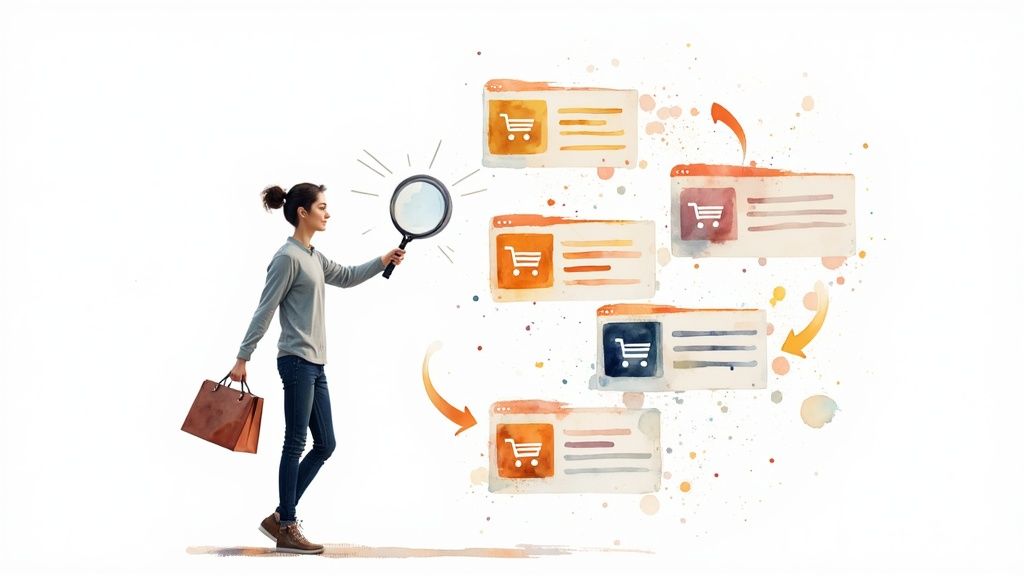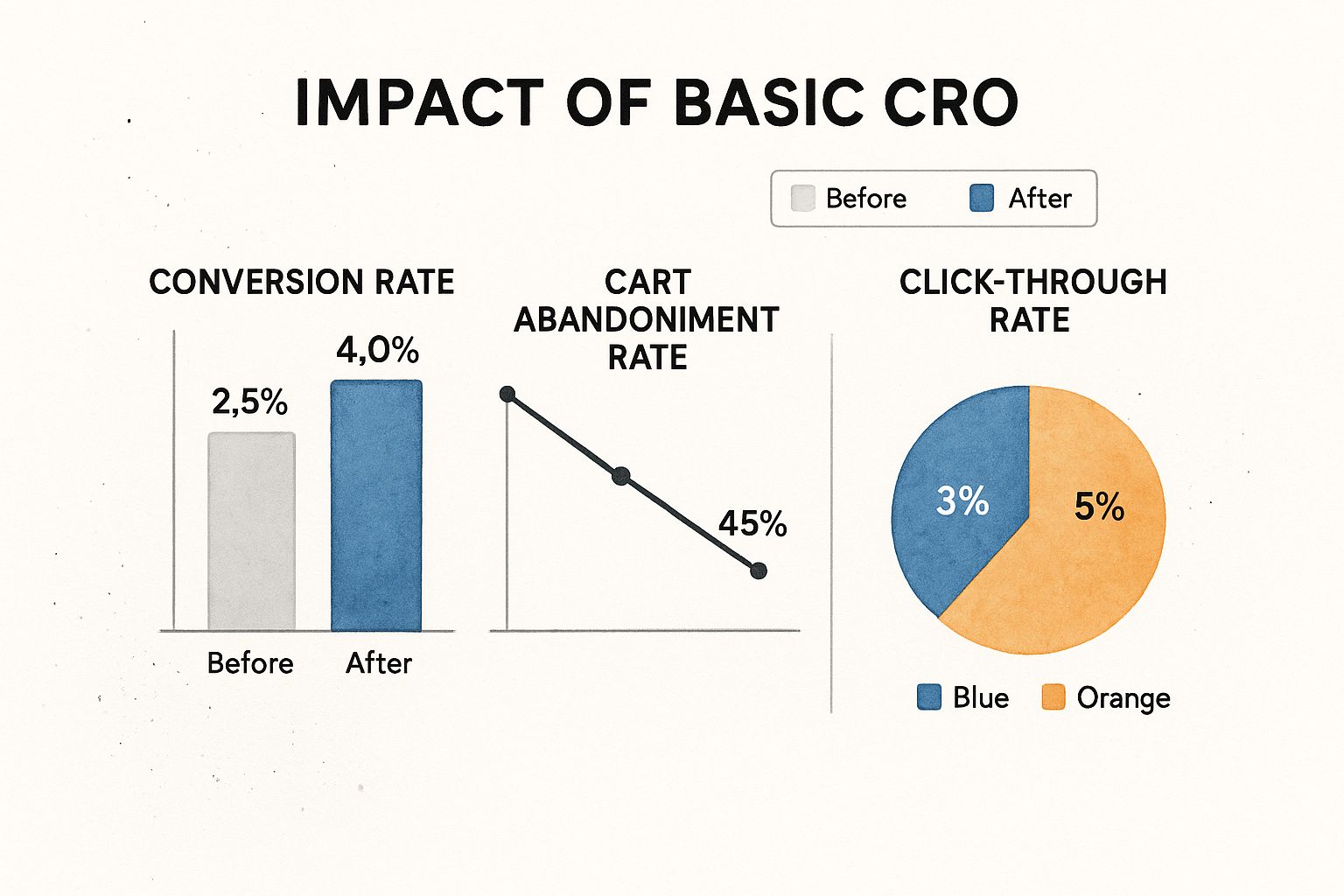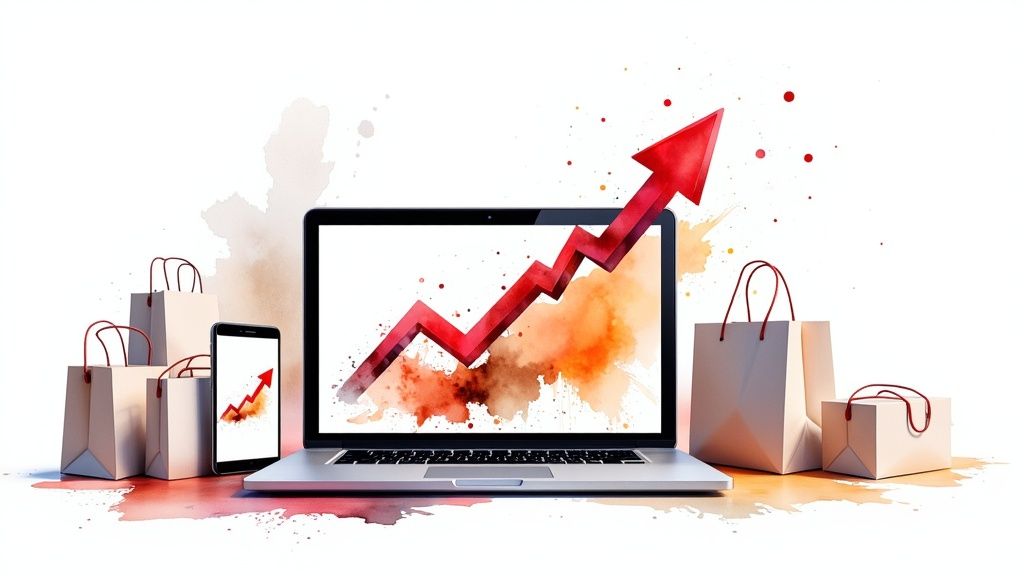Learn how to increase ecommerce sales with proven strategies. Boost your revenue through site optimization, marketing, and customer retention.
In This Article
Subscribe to our newsletter
When it comes to boosting your e-commerce sales, it's easy to get lost in complex marketing strategies. But honestly, it all comes back to two fundamental things: getting the right people to your website and making sure that site is built to convert them into customers.
Forget the "one weird trick" mentality. Real, sustainable growth comes from methodically shoring up your website's foundation—making it faster, more trustworthy, and dead simple to use.
Build a Website That Sells for You
Think of your e-commerce site as your digital flagship store. It's your top salesperson, your brand's home, and your customer service hub, all in one. Before you spend a single dollar on ads, you have to get this part right. A clunky, slow, or sketchy-looking website will bleed customers, no matter how much traffic you pour into it.
You wouldn't invite shoppers into a physical store with flickering lights, messy aisles, and a broken cash register, right? The same exact logic applies online. Your mission is to create a smooth, trustworthy, and intuitive shopping experience that effortlessly guides visitors from that first click all the way to checkout.
Prioritize Blazing-Fast Site Speed
Let's be blunt: in e-commerce, speed sells. A slow website is probably the fastest way to lose a sale. We've all been there—clicking on a link and waiting... and waiting... before finally giving up and hitting the back button.
Studies have shown time and again that even a one-second delay in page load time can cause a major drop in conversions. To see where you stand, use a free tool like Google's PageSpeed Insights. It gives you a no-nonsense breakdown of your site's performance on both mobile and desktop, plus a checklist of things to fix.
Here’s what a typical report looks like. It scores your site and pinpoints exactly what’s bogging it down.

This kind of report is your roadmap. It tells you if your images are too big or if your code is inefficient.
From my experience, the usual suspects slowing sites down are:
- Unoptimized Images: Huge, high-resolution photos are the number one killer of page speed. Use compression tools—you can shrink file sizes dramatically without a noticeable drop in quality.
- Bloated Code: Clunky themes and too many plugins can really weigh down your site. Always opt for a clean, lightweight theme as your base.
- Slow Hosting: You get what you pay for. If you're on a cheap, shared hosting plan, it might be time for an upgrade, especially as your traffic grows.
Embrace a Mobile-First Design Philosophy
The shift to mobile shopping isn't on the horizon; it’s already here. It’s expected that by 2024, nearly 72.9% of people will be making purchases through a mobile device. That’s not a trend, it's the reality of modern commerce. For more on this, cimulate.ai has some great statistics.
This means you need to design for mobile users first and then make sure it looks good on a desktop, not the other way around.
A mobile-first approach forces you to prioritize what's truly important. By designing for the smallest screen first, you naturally create a cleaner, more focused experience for everyone, no matter what device they're on.
A great mobile site has big, easy-to-tap buttons, simple menus, and a checkout process that doesn't feel like you’re trying to do your taxes on a tiny screen.
Establish Unbreakable Trust with Shoppers
In e-commerce, trust is everything. Customers are about to give you their personal and financial information, so they need to feel 100% confident that it’s safe. Even a tiny sliver of doubt can be enough to make them abandon their cart.
You can build that all-important trust in a few key ways:
- Display Security Badges: Make sure you're showing logos from trusted security providers like Norton, McAfee, or your SSL certificate. The footer and checkout page are prime real estate for these.
- Showcase Authentic Reviews: Nothing builds confidence like social proof. Integrate a solid review platform and let real customers tell your story for you. Shoppers trust other shoppers more than they'll ever trust you.
- Be Transparent with Policies: Don’t hide your shipping, return, and privacy policies. Make them incredibly easy to find and written in plain English. Clear, fair policies remove uncertainty and calm any pre-purchase jitters.
This checklist provides a quick audit of the foundational elements every e-commerce site needs to get right.
Core Website Optimization Checklist
| Optimization Area | Key Action | Impact on Sales |
|---|---|---|
| Site Speed | Compress all images and use a lightweight theme. Test with PageSpeed Insights. | Faster sites reduce bounce rates and directly improve conversion rates. |
| Mobile Experience | Test your entire shopping journey on a real phone. Is it simple and intuitive? | A seamless mobile experience captures the majority of online shoppers. |
| Trust Signals | Prominently display security badges, real customer reviews, and clear policies. | Building confidence reduces cart abandonment and encourages repeat business. |
| Navigation | Ensure your menu is simple and product categories are logical. | If users can't find what they're looking for, they can't buy it. |
Getting these core pillars—speed, mobile usability, and trust—nailed down creates an online store where customers feel comfortable, confident, and ready to click "buy." This isn't just a nice-to-have; it's the essential first step to growing your sales for the long haul.
Drive High-Intent Traffic to Your Store
A beautifully designed website is a great start, but it's only half the story. To really move the needle on sales, you need a steady stream of the right kind of visitors—people who are actively looking for exactly what you sell. Simply casting a wide net and hoping for the best is a surefire way to burn through your marketing budget. The real goal is to attract high-intent traffic that’s ready to buy.
This means you have to be proactive. You can't just wait for people to find you. It takes a smart, multi-channel strategy that puts your brand front and center the moment a potential customer starts looking. A solid approach will blend organic search, precision-targeted paid ads, and authentic content to keep your digital storefront busy with eager shoppers.
Capture Ready-to-Buy Shoppers with SEO
Search Engine Optimization (SEO) is hands-down your most powerful tool for bringing in free, organic traffic. Think about it: when someone types "waterproof hiking boots for women" into Google, they aren't just window shopping. They have a problem to solve and are likely ready to make a purchase. SEO is the craft of making sure your product page is one of the first things they see.
A great place to start is with long-tail keywords. These are longer, more specific phrases that might have less search volume but boast much higher conversion rates. For example, instead of going after a massive term like "skincare," you’ll have far more success targeting something like "vegan hyaluronic acid serum for sensitive skin." That kind of specificity pulls in a visitor who knows precisely what they need.
Here are a few practical ways to beef up your e-commerce SEO:
- Dial-In Your Product Pages: Make sure every product title, description, and image alt-text is loaded with relevant keywords. Write compelling, benefit-focused descriptions that proactively answer the questions a customer might have.
- Build Out Category Pages: Well-organized category pages are crucial. They help both your customers and the search engines understand how your site is structured. These pages are perfect for optimizing broader terms, like "women's hiking boots."
- Create a Content Hub: Start a blog or a resource center filled with genuinely helpful articles that relate to what you sell. If you sell kitchenware, an article on "How to Choose the Best Non-Stick Pan" is a perfect opportunity to naturally link to the pans you offer.
Launch Paid Campaigns That Prioritize ROI
Paid advertising on platforms like Google and Meta gives you immediate visibility and is the perfect complement to your long-term organic efforts. The secret, though, is to be obsessed with Return on Investment (ROI), not just vanity metrics like clicks or impressions.
Google Ads, for instance, lets you put your products right in front of people who are typing in search terms with clear buying intent.
Here’s a glimpse of the Google Ads platform, where you can build these highly targeted campaigns.

This dashboard is your command center for reaching customers through search, shopping, and display ads when they're most likely to convert.
On the social media side, platforms from Meta (think Facebook and Instagram) offer incredibly granular audience targeting. You can zero in on users based on their interests, online behaviors, and even past interactions with your site.
Pro Tip: Never, ever send paid traffic to your homepage. Create dedicated landing pages for each campaign that directly reflect the ad's promise. If your ad promotes a 20% discount on running shoes, the landing page better have that offer and those shoes front and center.
Build an Audience with Authentic Content Marketing
Content marketing is all about building a relationship by providing real value, not just shouting "buy now!" all the time. This strategy builds trust and establishes your brand as an expert in your field, which pays off massively down the road.
And don't just think blog posts. Engaging content comes in all shapes and sizes:
- Product Videos: Shoot short, snappy videos that show your product in action. Highlight its best features and demonstrate how it solves a real problem for your customer.
- How-To Guides: If you sell craft supplies, a detailed, step-by-step guide for a cool project will attract exactly the right kind of people to your store.
- User-Generated Content (UGC): Encourage your customers to share photos and videos of themselves using your products. Reposting this on your social media is powerful, authentic social proof that money can't buy.
With the explosion of social commerce, it's also critical to optimize your presence on TikTok Shop and similar platforms. These channels blur the lines between content and commerce, letting people discover and buy products without ever leaving their social feed. This direct path from inspiration to checkout is a game-changer, especially for driving impulse buys and connecting with younger audiences right where they hang out.
Turn Your Website Visitors into Customers
Getting traffic to your site is a great start, but it's only half the job done. The real challenge—and where you see serious growth—is turning those casual browsers into actual paying customers. This whole process is called Conversion Rate Optimization (CRO), and it's less about massive, expensive redesigns and more about making smart, targeted tweaks that boost your revenue.
It’s about obsessing over the details that nudge a buyer toward a decision. Think everything from the clarity of your product copy to the color of that "Add to Cart" button.
Craft Product Pages That Persuade and Sell
Your product page is your virtual salesperson. This is the moment where a shopper's curiosity either turns into a firm "yes" or they hit the back button and disappear. To make sure your pages are pulling their weight, every single element needs to be working for you.
Let’s start with visuals. Since your customers can't physically hold the product, your photos and videos have to do all the heavy lifting. High-quality, professional shots from every conceivable angle are non-negotiable. Show your product in action, zoom in on the important features, and give a clear sense of its size and scale.
Next, you need to write product descriptions that connect with your ideal customer's problems and aspirations. Don't just list what your product is; explain what it does for them.
- Feature: "Waterproof nylon fabric."
- Benefit: "Stay completely dry and comfortable on your hike, no matter what the weather throws at you."
See the difference? This simple shift helps people picture themselves using your product and feeling the benefits, which is a huge part of the buying decision.
Streamline Your Checkout to Slash Abandonment
A clunky, confusing checkout is the number one reason people abandon their carts. The average cart abandonment rate is staggering—around 70%—and a difficult checkout process is almost always the main culprit. Every extra step, every unnecessary form field, every surprise fee is just another reason for someone to give up and leave.
Your mission is to make buying from you as painless as possible.
Think of your checkout as the final sprint in a race. You've done all the hard work to get the customer this far; don't let them trip right before the finish line. Simplify, clarify, and guide them smoothly to that confirmation page.
Here are a few quick wins that can make a huge difference:
- Offer a Guest Checkout Option: Forcing someone to create an account is a massive roadblock. Let people buy as a guest, always.
- Be Transparent with Costs: Nobody likes getting hit with surprise fees at the very end. Show all costs, including shipping and taxes, right from the start.
- Use a Progress Indicator: A simple bar showing customers where they are in the process (e.g., Shipping > Payment > Confirm) can reduce anxiety and keep them moving forward.
- Keep Forms Minimal: Only ask for what you absolutely need to fulfill the order. If you can cut a field, cut it.
The Power of A/B Testing Small Changes
So, how do you actually know if changing your "Buy Now" button from blue to orange will increase sales? You test it. This is where A/B testing (also called split testing) comes in. It's a straightforward method where you show two versions of a page to different groups of visitors to see which one performs better.
This data-driven approach takes the guesswork out of website optimization. Instead of going with your gut, you're letting real user behavior tell you what works. You can test almost anything:
- Headlines and call-to-action (CTA) text
- Button colors, sizes, and where you place them
- Different product page layouts
- The images or videos you use
- Various promotional offers
The infographic below highlights how even a few fundamental CRO tweaks can have a major impact on your most important metrics.

As you can see, something as simple as a higher-contrast CTA button or a cleaner checkout flow can directly lead to more sales and fewer people ditching their carts. These aren't just minor cosmetic changes; they're small adjustments that can have a measurable impact on your bottom line.
Use Data to Personalize the Shopping Experience
If you're still using a one-size-fits-all marketing approach, you're leaving money on the table. Today's shoppers don't just appreciate a personal touch—they expect it. Digging into your customer data is hands-down the best way to create a shopping experience that feels relevant and engaging, which is a game-changer for boosting e-commerce sales.
When you show customers you actually understand their needs and what they’re looking for, they're not only more likely to buy from you, but they’ll also keep coming back. This isn't about being creepy; it's about being genuinely helpful every step of the way.
Segment Your Audience for Hyper-Relevant Messaging
First things first: stop thinking of your customers as one giant, faceless crowd. It's time to slice and dice your data to create smaller, focused segments based on real behavior and traits. This is how you send the right message to the right person at exactly the right time.
For instance, you could start building segments based on:
- Purchase History: Group together customers who buy similar products. If someone has a history of buying running shoes, they’re the perfect person to tell about your new line of athletic socks.
- Browsing Behavior: Go after shoppers who clicked around a specific product category but never added anything to their cart. A gentle email reminder or a small, exclusive offer could be just the nudge they need to commit.
- Customer Status: You shouldn't talk to a first-time buyer the same way you talk to a loyal fan. A welcome discount is great for a new shopper, but a VIP-exclusive offer makes your long-time customers feel truly valued.
This kind of targeting makes your marketing feel less like a generic ad blast and more like a thoughtful recommendation from a friend.
Automate Your Key Customer Touchpoints
Marketing automation is your secret weapon for delivering these personalized experiences without having to do it all manually. By setting up automated workflows (often called "flows"), you can make sure every customer gets the attention they deserve, and every interaction feels meaningful. These aren't just robotic, spammy emails; they are timely, helpful messages triggered by what a customer actually does.
Think of automation as having a dedicated assistant for every single customer. This assistant remembers what they like, when they last shopped, and what might bring them back, allowing you to build relationships 24/7 without lifting a finger.
For any e-commerce store, there are three automations you absolutely need to have running:
- Abandoned Cart Flow: This is non-negotiable. Sending a series of emails to remind a customer about items they left in their cart can recover a huge amount of otherwise lost revenue. You’d be surprised how often a simple reminder is all it takes.
- Welcome Series: This flow is your first handshake with a new subscriber. It's your chance to make a fantastic first impression, share your brand's story, and maybe sweeten the deal with a small incentive on their first purchase.
- Post-Purchase Follow-Up: Your work isn’t done after the sale. A quick thank-you email, a request for a review, or even some tips on how to care for their new product can build massive goodwill and pave the way for their next purchase.
Leverage Predictive Analytics and AI
Modern tools have made it easier than ever to figure out what your customers want, sometimes even before they do. By analyzing past behavior, predictive analytics and AI can serve up incredibly accurate product recommendations. You’ve seen this on sites like Amazon with their "Customers who bought this also bought..." suggestions.
Putting this kind of tech to work on your own site can dramatically increase your average order value. For example, a shopper looking at a coffee maker could automatically be shown compatible filters, a popular brand of coffee beans, and a top-rated mug. These are all things that just make sense.
With a global market that’s exploding—over three billion people are expected to shop online by 2025—using technology to create these tailored experiences is crucial. In fact, e-commerce is projected to make up 22.5% of total retail sales by 2028. You can explore more about these global ecommerce trends to see how data-driven strategies are shaping the industry. This approach effectively turns your website into a smart, proactive salesperson that’s always ready with a helpful suggestion.
Personalization Tactics Comparison
Deciding where to start with personalization can be overwhelming. Some methods are quick wins, while others require more technical setup but offer a bigger payoff. This table breaks down a few common tactics to help you prioritize.
| Tactic | Complexity | Potential ROI |
|---|---|---|
| Segmented Email Campaigns | Low | Medium |
| Abandoned Cart Emails | Low-Medium | High |
| Personalized Product Recommendations | Medium-High | Very High |
| Dynamic On-Site Content | High | Very High |
| Geographic Targeting | Low-Medium | Medium |
Ultimately, even starting with a simple tactic like segmenting your email list can have a noticeable impact. The key is to begin gathering and using your data to make every customer feel like you're speaking directly to them.
Create Loyalty and Increase Customer Lifetime Value

It’s easy to get obsessed with bringing new customers through the door. But the real, sustainable growth in e-commerce comes from what you do after that first sale. Honestly, getting a new customer costs a fortune compared to keeping an existing one happy.
This is where you shift from making a single transaction to building a genuine relationship. Focusing on what happens post-purchase is one of the smartest ways to boost your sales over the long haul. It's all about fostering real loyalty and implementing smart strategies to increase customer lifetime value.
Turn Customer Service into a Marketing Engine
Great customer service isn't just a problem-solving department; it’s one of your most powerful marketing channels. Think about it: when an order is delayed or a product arrives damaged, you've got a make-or-break moment. You can either lose a customer forever or create a raving fan for life.
A customer with an issue is already highly engaged. If you swoop in with a fast, empathetic, and generous solution, you don't just fix a problem—you show them you actually care. That's how you earn deep trust and priceless word-of-mouth marketing.
Here’s how to build a service operation that wins people over:
- Make it easy to talk to you. Offer live chat, email, and a phone number that’s easy to find. Nobody wants to hunt through three pages of FAQs just to find a contact form.
- Empower your team to be heroes. Give your support reps the freedom to solve problems on the spot. Let them offer a discount, a replacement, or free shipping without needing a manager's approval.
- Speed is your best friend. Acknowledge every inquiry instantly, even with an auto-reply. Then, aim to resolve the actual issue in hours, not days. Quick action shows respect.
Design Loyalty Programs That Actually Work
Let's be real: most loyalty programs are forgettable. A great program shouldn't just be about tossing out random discounts. It needs to make your customers feel like they're part of an exclusive club. The goal is to give them a compelling reason to come back to you every single time.
A simple points-based system is often the best place to start. It’s straightforward: customers earn points for purchases, which they can cash in for discounts or special products. No complex rules, just clear value.
A loyalty program shouldn't just be about transactions. Use it to build a community. Offer early access to new products, exclusive content, or members-only sales to make your best customers feel truly special and appreciated.
Another fantastic model is a tiered program. As customers spend more over their lifetime, they "level up" to unlock better perks, like permanent free shipping or bigger discounts. This adds a fun, game-like element to shopping and encourages people to stay engaged with your brand. Just make sure the rewards are both desirable and feel within reach.
Actively Collect and Implement Customer Feedback
Your customers know your business better than almost anyone. They'll tell you exactly what’s working, what’s broken, and what you should do next—you just have to ask. Proactively seeking out their feedback is a powerful way to show you value their opinion and are serious about getting better.
Post-purchase surveys are a goldmine for this. A few days after an order arrives, an automated email can do the trick.
Just be sure to keep it short and sweet. Focus on the big things:
- Product Satisfaction: Did it live up to the hype?
- Website Experience: Was it a breeze to find what they needed and check out?
- Overall Vibe: How likely are they to tell a friend about you? (This gives you your Net Promoter Score, or NPS).
But collecting feedback is only half the battle. The real value comes from digging into the responses, spotting trends, and then actually doing something about it. If people are confused by a product description, rewrite it. If shipping times are a constant complaint, it's time to look at your logistics.
This feedback loop is what separates good brands from great ones. It shows you're listening and evolving. And as the global e-commerce market rockets toward a projected $6.42 trillion in 2025, creating that responsive, customer-first experience is what will make you stand out.
Answering Your Top Questions About Ecommerce Growth
When you're trying to grow your online store, it feels like you're pulled in a hundred different directions. Everyone has advice, but what actually works? It’s easy to get bogged down, so let's cut through the noise and tackle the questions I hear most often from store owners.
Getting straight answers to these common questions is the key to focusing your energy where it will make the biggest impact on your sales.
What Metrics Actually Matter for Growth?
It's tempting to chase big numbers like website traffic or Instagram followers, but those are often just vanity metrics. They look good on paper, but they don't always translate into actual revenue. If you want to see real, sustainable growth, you need to focus on the numbers that directly reflect your store's financial health and customer relationships.
Here are the four metrics I tell every store owner to live and breathe:
- Conversion Rate: This is your holy grail. It's the percentage of visitors who actually buy something. A low conversion rate means you're leaving money on the table, no matter how much traffic you get.
- Average Order Value (AOV): Simply put, this is how much the average customer spends per order. Bumping this number up is one of the quickest ways to increase revenue without spending more on marketing.
- Customer Lifetime Value (CLV): This is the long game. CLV tells you how much a single customer is worth to your business over time. A rising CLV is a sure sign you're building a loyal customer base that keeps coming back.
- Cart Abandonment Rate: This one hurts, but you have to watch it. It's the percentage of people who add products to their cart and then bail before paying. A high rate is a massive red flag, usually pointing to a clunky checkout process or unexpected costs.
Keeping a close eye on these four will give you a brutally honest look at how your business is performing and show you exactly where to focus your efforts.
How Can a New Store Get Some Quick Wins?
Getting those first few sales for a new store can feel like an uphill battle. You're building everything from scratch, and long-term strategies like SEO take time to kick in. You need some immediate traction to build momentum and, just as importantly, your confidence.
For a new store, early sales aren't just about revenue; they're about validation. Every order is proof that your products resonate with customers and that your systems are working, building the confidence you need to scale.
If you're looking for some high-impact tactics to get the ball rolling, here are a few I've seen work time and time again:
- Host a Killer Launch Giveaway: Don't go it alone. Team up with a few brands that share your target audience and run a joint giveaway. It's a fantastic way to quickly grow your email list and social following with people who are genuinely interested in what you offer.
- Create an Unbeatable Welcome Offer: First impressions matter. A juicy, time-sensitive discount for first-time shoppers can be the perfect push they need to go from "just looking" to "sold."
- Lean into User-Generated Content (UGC): From your very first customer, encourage them to share photos of your products in action. When you repost this content, it acts as powerful, authentic social proof that new visitors will trust far more than any slick marketing ad.
These aren't long-term solutions, but they're designed to create a buzz and bring in those critical first sales that you can build on.
Ready to transform your content into high-impact videos that drive sales? Aeon automates video creation, allowing you to produce engaging, on-brand content at scale with minimal effort. Discover how our AI-powered platform can boost your engagement and revenue by visiting the Aeon website.


.jpg)